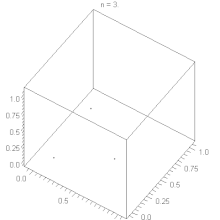George Marsaglia
George Marsaglia (March 12, 1924 – February 15, 2011)[1] was an American mathematician and computer scientist. He is best known for creating the diehard tests, a suite of software for measuring statistical randomness.
George Marsaglia | |
|---|---|
| Born | March 12, 1924 |
| Died | February 15, 2011 (aged 86) |
| Nationality | American |
| Alma mater | Ohio State University |
| Scientific career | |
| Fields | Mathematics |
| Institutions | Florida State University Washington State University |
| Doctoral advisor | Henry Mann |
Research on random numbers

George Marsaglia established the lattice structure of linear congruential generators in the paper "Random numbers fall mainly in the planes",[2] later termed the Marsaglia's theorem.[3] This phenomenon means that n-tuples with coordinates obtained from consecutive use of the generator will lie on a small number of equally spaced hyperplanes in n-dimensional space.[4] He also developed the diehard tests, a series of tests to determine whether or not a sequence of numbers have the statistical properties that could be expected from a random sequence. In 1995 he published a CD-ROM of random numbers, which included the diehard tests.[5]
His diehard paper came with the quotation "Nothing is random, only uncertain" attributed to Gail Gasram, though this was simply the reverse of Marsaglia G.
He also developed some of the most commonly used methods for generating random numbers and using them to produce random samples from various distributions. Some of the most widely used being the multiply-with-carry, subtract-with-borrow, xorshift, KISS and Mother methods for random numbers, and the ziggurat algorithm for generating normally or other unimodally distributed random variables.
Life
He was Professor Emeritus of Pure and Applied Mathematics and Computer Science at Washington State University and Professor Emeritus of Statistics at Florida State University.
In the 1995 CD-ROM release of diehard, Marsaglia included several papers that outline the process by which the random number files were created. In several places he mentions that, along with deterministic and physical devices:
"Some of the files had white noise combined with black noise, the latter from digital recordings of rap music. And a few of the files even had naked ladies thrown into the mix."[6]
Marsaglia died from a heart attack on February 15, 2011, in Tallahassee.[1]
See also
References
- "George Marsaglia Obituary". Tallahassee Democrat. 2011-02-22. Retrieved 2017-01-18.
- George Marsaglia (1968). "Random numbers fall mainly in the planes" (PDF). PNAS. 61 (1): 25–28. doi:10.1073/pnas.61.1.25. PMC 285899. PMID 16591687.
- Winton, Charles (2008). Review of Statistical Terminology (PDF). University of North Florida, statistics class notes. p. 20.
- Dr. John Ramirez (2001-07-24). "Random Numbers". Retrieved 2017-01-18.
- "The Marsaglia Random Number CDROM including the Diehard Battery of Tests of Randomness". Florida State University. 1995. Archived from the original on 2016-01-25.
- Marsaglia, George. "The Marsaglia Random Number CDROM". Department of Statistics. Archived from the original on 27 February 2015. Retrieved 23 November 2019.
Further reading
- Marsaglia, George; Tsang, Wai Wan (1998). The Monty Python method for generating random variables. ACM Transactions on Mathematical Software (TOMS). 24. pp. 341–350. doi:10.1145/292395.292453.
- Marsaglia, George; Tsang, Wai Wan (2000-10-02). "The Ziggurat Method for Generating Random Variables". Journal of Statistical Software. 5 (8). doi:10.18637/jss.v005.i08.
- George Marsaglia (2003-05-13). "good C random number generator". comp.lang.c newsgroup.
- Marsaglia, Zaman, Zheng; et al. (2007-03-20). "C309. An algorithm for the area of the union of a collection of convex sets". Journal of Statistical Computation and Simulation. 31 (1): 46–49. doi:10.1080/00949658908811112.CS1 maint: multiple names: authors list (link)
- George Marsaglia at the Mathematics Genealogy Project